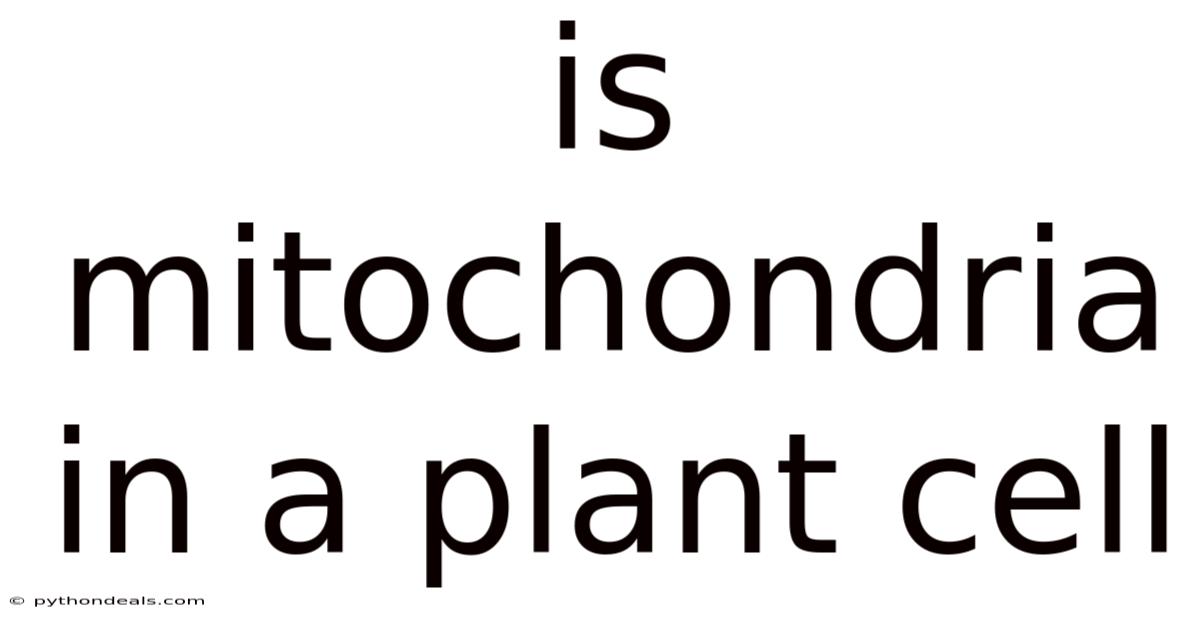Is Mitochondria In A Plant Cell
pythondeals
Nov 14, 2025 · 4 min read

Table of Contents
Let's delve into the fascinating world of cellular biology to explore whether mitochondria exist within plant cells. It's a question that sits at the heart of understanding energy production and the fundamental differences and similarities between plant and animal cells. So, buckle up as we unravel the complexities of plant cell structure and the vital role mitochondria play in it.
Unveiling the Presence of Mitochondria in Plant Cells
Mitochondria, often dubbed the "powerhouses of the cell," are indeed present in plant cells. They are crucial organelles responsible for generating energy through cellular respiration. This process converts sugars produced during photosynthesis into a usable form of energy called adenosine triphosphate (ATP), which fuels various cellular activities.
The presence of mitochondria in plant cells is a fundamental aspect of their biology. While plants are renowned for their ability to photosynthesize, this process alone doesn't provide all the energy a plant cell needs. Photosynthesis produces sugars, but mitochondria are essential for breaking down those sugars and releasing energy in a controlled and accessible manner.
Comprehensive Overview: Mitochondria in Plant Cells
To fully grasp the role of mitochondria in plant cells, we need to delve into their structure, function, and significance.
- Structure of Mitochondria: Mitochondria are complex organelles characterized by their double-membrane structure. The outer membrane is smooth, while the inner membrane is highly folded into structures called cristae. These cristae increase the surface area available for the reactions of cellular respiration. The space between the two membranes is the intermembrane space, and the space enclosed by the inner membrane is the mitochondrial matrix. The matrix contains enzymes, ribosomes, and mitochondrial DNA.
- Function of Mitochondria:
The primary function of mitochondria is to produce ATP through cellular respiration. This process involves a series of biochemical reactions that occur in different parts of the mitochondria:
- Glycolysis: This initial step occurs in the cytoplasm and breaks down glucose into pyruvate.
- Krebs Cycle (Citric Acid Cycle): Pyruvate is transported into the mitochondrial matrix, where it is converted into acetyl-CoA and enters the Krebs cycle. This cycle generates ATP, NADH, and FADH2.
- Electron Transport Chain (ETC): NADH and FADH2 donate electrons to the ETC, which is located on the inner mitochondrial membrane. As electrons move through the chain, protons are pumped from the matrix to the intermembrane space, creating an electrochemical gradient.
- Oxidative Phosphorylation: Protons flow back into the matrix through ATP synthase, an enzyme that uses the energy from the proton gradient to synthesize ATP.
Key roles and significance:
- Energy Production: Mitochondria are responsible for ATP production. They break down the sugars produced during photosynthesis to create usable energy for the cell. This energy fuels processes such as growth, development, and nutrient transport.
- Cellular Respiration: Mitochondria are where cellular respiration occurs. This is a vital process in all eukaryotic cells, including those in plants.
- Metabolic Processes: Mitochondria help with various metabolic processes in plant cells, including synthesis of amino acids and heme.
- Apoptosis: Also known as programmed cell death, apoptosis is an important function that mitochondria assist with.
- Calcium Signalling: Mitochondria play a vital role in calcium homeostasis which is crucial to cell signaling.
Tren & Perkembangan Terbaru
Recent research has shed light on the intricate relationship between mitochondria and other organelles in plant cells. For instance, studies have shown that mitochondria interact closely with chloroplasts, the organelles responsible for photosynthesis. These interactions are crucial for coordinating energy production and metabolism within the cell.
Furthermore, advances in microscopy techniques have allowed scientists to visualize mitochondria in plant cells with unprecedented detail. These observations have revealed that mitochondria are highly dynamic organelles that can change shape, move around within the cell, and even fuse or divide.
Tips & Expert Advice
To understand mitochondria better, consider these tips:
- Learn the basics of cellular respiration: Understanding the steps involved in cellular respiration is essential for grasping the role of mitochondria in energy production.
- Explore the structure of mitochondria: Familiarize yourself with the different parts of the mitochondria, such as the outer membrane, inner membrane, cristae, and matrix.
- Investigate the interactions between mitochondria and other organelles: Learn how mitochondria interact with chloroplasts and other organelles to coordinate cellular activities.
FAQ
- Q: Are mitochondria only found in animal cells?
- A: No, mitochondria are found in both animal and plant cells.
- Q: Can plant cells survive without mitochondria?
- A: No, mitochondria are essential for energy production and other vital cellular processes.
- Q: How do mitochondria get into plant cells?
- A: Mitochondria are inherited from the maternal parent during sexual reproduction.
Conclusion
In conclusion, mitochondria are integral components of plant cells, playing a vital role in energy production and other cellular processes. Their presence underscores the fundamental similarities between plant and animal cells. By understanding the structure and function of mitochondria, we gain valuable insights into the inner workings of plant cells and the intricate mechanisms that sustain life. How do you feel about the significance of mitochondria in plant cell function? Do you find it fascinating how these organelles contribute to energy production, bridging the gap between photosynthesis and cellular respiration?
Latest Posts
Latest Posts
-
Find The Inverse Of A 3x3 Matrix
Nov 14, 2025
-
The Positive Ion In A Compound
Nov 14, 2025
-
How To Find Critical Value Statistics
Nov 14, 2025
-
Chemical Formula Of Titanium Iv Oxide
Nov 14, 2025
-
Where Is The Umbilical Region Located
Nov 14, 2025
Related Post
Thank you for visiting our website which covers about Is Mitochondria In A Plant Cell . We hope the information provided has been useful to you. Feel free to contact us if you have any questions or need further assistance. See you next time and don't miss to bookmark.